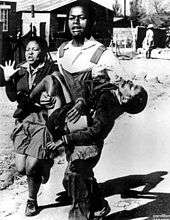Hector Pieterson

Hector Pieterson (1963 – 16 June 1976) became the subject of an iconic image of the 1976 Soweto uprising in South Africa when a news photograph by Sam Nzima of the dying Hector being carried by another student while his sister ran next to them, was published around the world. He was killed at the age of 13 when the police opened fire on protesting students. For years, 16 June stood as a symbol of resistance to the brutality of the apartheid government. Today, it is designated National Youth Day — when South Africans honour young people and bring attention to their needs.
Soweto Uprising
On 16 June 1976, school children protested the implementation of Afrikaans and English as dual medium of instruction in secondary schools in a 50:50 basis. This was implemented throughout South Africa regardless of the locally-spoken language and some exams were also written in Afrikaans.[1] Students gathered to peacefully demonstrate, but the crowd soon became very aggressive when the police arrived, they then started to throw stones.[2] A crowd of approximately 10,000 started rioting, killing two West Rand Administrative Board members, and burning a number of dogs, vehicles and buildings associated with the police and the Transvaal Education Department. [3]
A group of 30 students gathered outside the Phefeni Junior Secondary School singing the traditional Sotho anthem 'Morena Boloka Sechaba Sa Heso'. When the police arrived the crowd became violent, throwing rocks at the police. The police in turn fired tear gas into the crowd in order to disperse them. There are conflicting accounts of who gave the first command to shoot, but soon children were turning and running in all directions, leaving some children lying wounded on the road.
Although the media often named Hector as the first child to die that fateful day, another boy, Hastings Ndlovu, was actually the first child to be shot. But in the case of Hastings, there were no photographers on the scene, and his name was not immediately known.
When Hector was shot, he fell on the corner of Moema and Vilakazi Streets, he was picked up by Mbuyisa Makhubo (an 18-year-old schoolboy) who together with Hector's sister, Antoinette (then 17 years old), ran towards Sam Nzima's car. They bundled him in, and the journalist Sophie Tema[4] drove him to a nearby clinic where he was pronounced dead. Mbuyisa and Nzima were harassed by the police after the incident and both went into hiding. Mbuyisa's mother told the Truth and Reconciliation Commission that she received a letter from Mbuyisa in 1978 from Nigeria but she has not heard from him since.[5] Hector and Hastings Ndlovu are buried at the Avalon Cemetery, Soweto.
Surname
Since June 1976, Hector's surname has been spelled Peterson and Pietersen by the press but the family insists that the correct spelling is Pieterson. The Pieterson family was originally the Pitso family but decided to adopt the Pieterson name to try to pass as Coloured, a different ethnic group under the Apartheid system of racial classification, because Coloured people enjoyed somewhat better privileges under apartheid than blacks did.[6]
Controversial lawsuit
On 9 August 2002 U.S. lawyer Ed Fagan led a $50bn class action suit by apartheid-era victims against international firms and banks who profited from dealings with the Apartheid regime. Among the plaintiffs in the lawsuit is Dorothy Molefi, Hector's mother. The South African government as well as Nelson Mandela, Thabo Mbeki and Desmond Tutu have distanced themselves from the lawsuit.[7] Fagan is known for a string of lawsuits over human-rights issues brought in order to force companies to settle. The cases were thrown out in 2004.[8]
Memorial and museum
On 16 June 2002 the Hector Pieterson Memorial and Museum was opened near the place he was shot in Orlando West, Soweto to honour Hector and those who died around the country in the 1976 uprising. Funded by the Department of Environmental Affairs and Tourism (R16-million) and the Johannesburg City Council (R7,2 million), it has become a major tourist attraction. The start of the museum begins with pictures of Hector Pierterson's death. The museum fuses memorabilia with modern technology and cultural history. Currently, in 2010, Hector's sister Antoinette, who is seen in the famous photograph, works at the museum as a tour guide.[9][10]
See also
References
- ↑ Afrikaans Medium Decree
- ↑ "Inquiry must be held into Soweto Riot". World. 17 June 1976.
- ↑ "Riot – Kruger speaks". World. 17 June 1976.
- ↑ Davie, Lucille (9 June 2005). "Museum gathers memories of '76". News Update. City of Johannesburg.
- ↑ "Transcript of a Human Rights Violation Hearing, CASE: GO/O133, 30 April 1996, Day 3". Johannesburg: Truth and Reconciliation Commission. 1996.
- ↑ martha golden was one of the kids who where protesting and was shot on left leg http://www.sowetotour.co.za/soweto-tour.html Soweto Tour
- ↑ "Multi-billion dollar Apartheid lawsuit kicks off". Mail & Guardian. 10 August 2002.
- ↑ "Court throws out apartheid cases". BBC News. 29 November 2004.
- ↑ Davie, Lucille (14 June 2002). "Hector the famous child whose face is unknown". News Update. City of Johannesburg.
- ↑ Davie, Lucille (24 October 2001). "Hector Pieterson gets his memorial". News Update. City of Johannesburg.